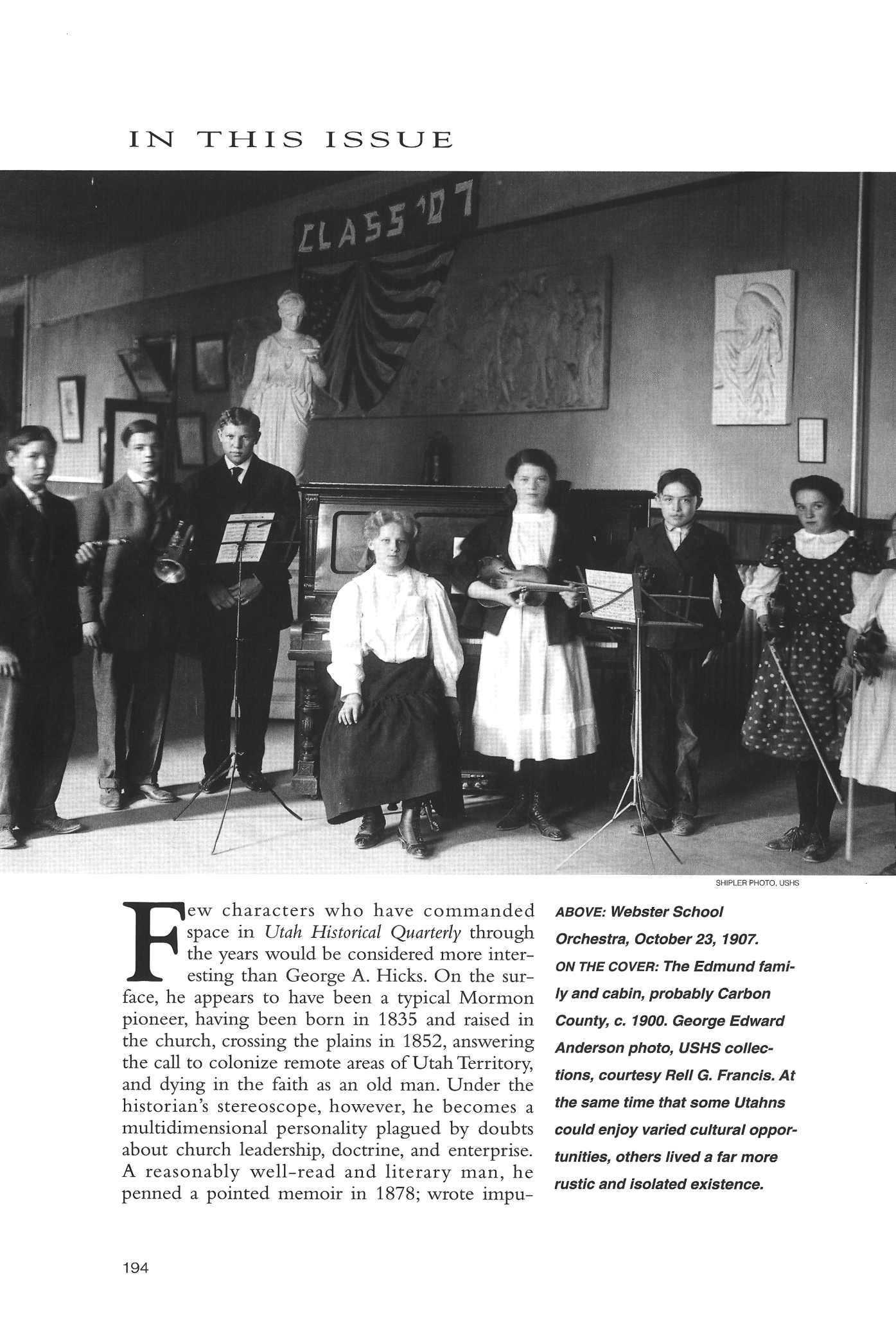
4 minute read
In This Issue
Few characters who have commanded space in Utah Historical Quarterly through the years would be considered more interesting than George A. Hicks. O n the surface, he appears to have been a typical Mormon pioneer, having been born in 1835 and raised in the church, crossing the plains in 1852, answering the call to colonize remote areas of Utah Territory, and dying in the faith as an old man Under the historian's stereoscope, however, he becomes a multidimensional personality plagued by doubts about church leadership, doctrine, and enterprise A reasonably -well-read and literary man, he penned a pointed memoir in 1878; wrote impudent letters to Brigham Young; alienated the testy Emma Lee, who threatened to "put a load of salt in his backside"; and may have even been excommunicated for a time. Readers of this issue will probably be affected by him the same way as were his contemporaries: some will like him, many will find him less than charming, and still others will smile and just shake their heads at his antics and eccentricities. All, no doubt, 'will admire the insightful, masterful way his complexities are handled by a very talented biographer in this engaging character study.
Equally offbeat is the subject of our second article, this time a place rather than a person Giles, in Blue Valley, Wayne County, was founded relatively late in the settlement era. Again, upon superficial study, it represents a typical experience. Here we see hard-working settlers seeking to make the desert blossom, scraping to pay their tithing, sacrificing to build a church house, persevering to establish an irrigation system, and reveling in each small triumph. Yet, from the beginning, Giles just seemed different. At community dances, "white eye" was frequently passed around, simmering family feuds popped open, and people went home with "busted noses and sore heads." Factionalism rent the town, and farmers slipped off to nearby mining communities for seasonal employment. N o matter how eloquent the promises of the dam builders, the river refused to be tamed and finally washed away most of the fields, orchards, hopes, and dreams Reflecting the distinctive idiom of master storyteller James W. Nielsen, this version of the Giles saga is a wonderfully entertaining mix of aspiration, action, images, and understated humor
We next shift our attention to Price during the 1930s-40s and pick up the lively beat of high school marching bands In that modest Carbon County city, thanks primarily to the vision and energy of one man, annual band competition took root and grew into a huge event. Planners scurried to arrange for excursion train fares and the loan of 1,300 army cots from Fort Douglas to accommodate the many students and other visitors, and townsfolk jockeyed for position on the sidewalks and rooftops to watch the bands compete. It was inexpensive and exciting fare for thousands during the often drab times of the depression and the worrisome days of the war, and no doubt our readership of today will relate to it on many different levels.
The final article also centers on an energetic and aspiring person during the '30s and '40s, Ada Quinn of Ogden Understanding the value that women of that era placed on aprons, she parlayed a talent for design and an appreciation for the practical in designing, manufacturing, and marketing that ubiquitous household item She had an amazing knack for producing just what the typical homemaker seemed to -want, and her business thrived. Equally interesting are her progressive views on employer-employee relations and her strong feelings about government regulation of the garment industry In fact, so determined was she to air her views on the latter subject that she earned a niche in Utah political history as a minor candidate in the state gubernatorial election of 1940. It is time that contemporary Utahns rediscover this remarkable entrepreneur
Here, then, is a variety of articles, none exceptionally heavy, all engaging, each different in style and focus, and every one guaranteed to add to your summertime reading pleasure. Enjoy.
ABOVE: Webster School Orchestra, October 23, 1907.







